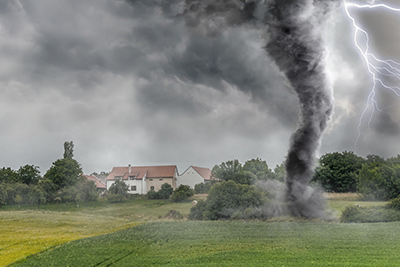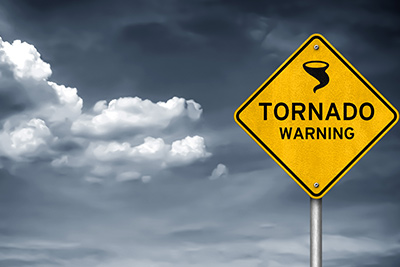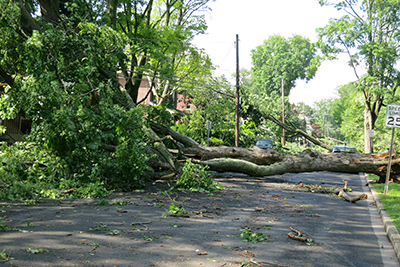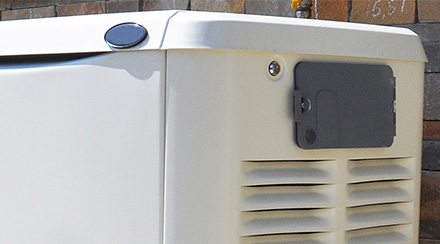Tornado Safety: How to Prepare and Stay Safe During a Tornado

Tornadoes are among the most dangerous and destructive severe weather events. While there are safeguards in place to help inform the public when tornado formation is possible or imminent, tornadoes can develop very quickly, leaving little time to prepare and take shelter. To ensure your safety and that of your family, it’s important to make some preparations far in advance and remain vigilant against the threat of severe weather.
What Is a Tornado?
Tornadoes are funnel-shaped, rotating columns of air that stretch all the way from storm clouds in the sky to the ground below. The most powerful tornadoes are capable of wind speeds in the 300 mph range, which can completely destroy homes and buildings, uproot mature trees, and fling large and heavy debris for miles in any direction.
What Causes Tornadoes?
Tornadoes form during specific thunderstorm conditions. When thunderstorm winds blow in one direction at ground level and in a different direction at higher elevations, the crosswinds can form a horizontal tunnel of air. At the same time, there may be another phenomenon occurring called an “updraft,” in which a column of warm air rises upwards toward the storm clouds. If an updraft occurs near one of these horizontal air tunnels, it can force the tunnel into a vertical position, forming a “supercell.” If the rotation of the supercell becomes organized, it can form a funnel cloud, and if that funnel cloud touches the ground, it becomes a tornado.
Where Do Tornadoes Occur?
Tornadoes are possible in many environments around the world, but some regions are especially prone to tornadoes during thunderstorm season. In the U.S., tornadoes are most common across the Midwest and Great Plains, between the Rocky Mountains and the Appalachian Mountains. An area encompassing most of Northern Texas, Oklahoma, Kansas, Nebraska, Iowa and South Dakota is sometimes referred to as “Tornado Alley” because of its high rate of tornado activity.
How to Prepare for a Tornado
When a tornado is imminent, it’s too late to prepare. You must have your preparations well in place by the beginning of thunderstorm season if you want to maximize your safety and awareness.
- Locate the safest tornado shelter in your home, workplace and any building where you spend a lot of time. This is usually the basement, but if there is no accessible basement, it’s an interior room with no windows.
- Prepare an emergency storm kit and store it in or near the best tornado shelter in your home. It should include non-perishable food and water (at least a three-day supply for the entire household), a first aid kit, important medications, flashlights, batteries and a battery-operated radio. If you have pets, include pet food and extra water for them. You may also want to include devices to help you recharge your phone, such as a power bank or a small solar charger.
- Create a family communications plan so that everyone in your household knows where to go and how to regroup in the event of a disaster.
- Sign up for text alerts on your mobile device from local authorities that issue severe weather warnings.
- Document your home and valuables with photos and lists. In the event of a destructive tornado, this can help you determine what is damaged or missing, which may help with a potential homeowner's insurance claim.
Tornado Watch vs. Tornado Warning

When your local weather authority issues a tornado watch, that means conditions are favorable for tornado development. If it issues a tornado warning, that means a tornado has been spotted, detected by meteorological equipment or is imminent. Tornado watches and warnings apply to defined areas (usually identified by city or county) and have expiration times. The expiration times may be extended, so it’s important to keep tabs on weather alerts until they’re fully expired.
What to Do When There Is a Tornado Watch
During a tornado watch, make sure you’re connected to a reliable weather or news source. If you aren’t tuned in to radio or TV, your mobile device should be nearby and set up to receive weather alerts. Unplug sensitive electronics that are not in use to avoid power surge damage.
Monitor the weather conditions from a safe structure. If you see high winds, low clouds, or green or orange tinted skies, they could be signs of favorable tornado conditions.
Consider contacting your other family members if you’re separated but within the same storm area. It may be helpful to know where your loved ones are in case they or you need to shelter in place.
What to Do During a Tornado Warning
When there is a tornado warning issued for your area, you should take immediate action. If you’re already inside a sturdy structure, you should go to the safest area for shelter and monitor the situation with a battery-operated radio or mobile device. Sheds, mobile homes and other non-reinforced structures are not considered safe shelters during a tornado.
If you’re outdoors or driving, you should immediately go to the nearest appropriate storm shelter. If you are far from any appropriate shelter, look for a ditch or low-lying area where you can take shelter from flying debris if necessary. Do not attempt to shelter under a bridge or highway overpass.
What to Do During a Tornado When It’s Active
Remain in your safest available shelter until the storm completely passes. Cover yourself and loved ones with blankets, if available, to offer protection from flying debris like broken glass.
If you are in a vehicle when a tornado strikes, keep your head low and cover the back of your head with your hands. If you are outdoors, find a ditch or the lowest lying area and lay face down with your hands covering the back of your head.
What to Do After a Tornado

When Tornadoes Strike, Survival Is Everything
Looking for Something Specific?
Select a category to find resources for topics that interest you.
Select Category

Related Articles:

What to Do Before, During and After Power Outages
With a little knowledge and preparation, you can protect yourself, your home and your belongings during power outages of any duration.
Read Article
How to Choose a Generator for Your Home
Power outages can be miserable, but with the right generator, you can keep your family safe and comfortable until power is restored. Learn how to choose the best generator for your home.
Read Article
Weatherize Your Home for Summer
The extreme heat of summer can really do a number on your energy bills. But if you’re able to invest a little time and money into weatherizing to keep your home cool, you can help yourself and your family remain comfortable at home while still saving energy.
Read ArticleTornado Safety: How to Prepare and Stay Safe During a Tornado
Tornadoes are among the most dangerous and destructive severe weather events. While there are safeguards in place to help inform the public when tornado formation is possible or imminent, tornadoes can develop very quickly, leaving little time to prepare and take shelter. To ensure your safety and that of your family, it’s important to make some preparations far in advance and remain vigilant against the threat of severe weather.
What Is a Tornado?
Tornadoes are funnel-shaped, rotating columns of air that stretch all the way from storm clouds in the sky to the ground below. The most powerful tornadoes are capable of wind speeds in the 300 mph range, which can completely destroy homes and buildings, uproot mature trees, and fling large and heavy debris for miles in any direction.
What Causes Tornadoes?
Tornadoes form during specific thunderstorm conditions. When thunderstorm winds blow in one direction at ground level and in a different direction at higher elevations, the crosswinds can form a horizontal tunnel of air. At the same time, there may be another phenomenon occurring called an “updraft,” in which a column of warm air rises upwards toward the storm clouds. If an updraft occurs near one of these horizontal air tunnels, it can force the tunnel into a vertical position, forming a “supercell.” If the rotation of the supercell becomes organized, it can form a funnel cloud, and if that funnel cloud touches the ground, it becomes a tornado.
Where Do Tornadoes Occur?
Tornadoes are possible in many environments around the world, but some regions are especially prone to tornadoes during thunderstorm season. In the U.S., tornadoes are most common across the Midwest and Great Plains, between the Rocky Mountains and the Appalachian Mountains. An area encompassing most of Northern Texas, Oklahoma, Kansas, Nebraska, Iowa and South Dakota is sometimes referred to as “Tornado Alley” because of its high rate of tornado activity.
How to Prepare for a Tornado
When a tornado is imminent, it’s too late to prepare. You must have your preparations well in place by the beginning of thunderstorm season if you want to maximize your safety and awareness.
- Locate the safest tornado shelter in your home, workplace and any building where you spend a lot of time. This is usually the basement, but if there is no accessible basement, it’s an interior room with no windows.
- Prepare an emergency storm kit and store it in or near the best tornado shelter in your home. It should include non-perishable food and water (at least a three-day supply for the entire household), a first aid kit, important medications, flashlights, batteries and a battery-operated radio. If you have pets, include pet food and extra water for them. You may also want to include devices to help you recharge your phone, such as a power bank or a small solar charger.
- Create a family communications plan so that everyone in your household knows where to go and how to regroup in the event of a disaster.
- Sign up for text alerts on your mobile device from local authorities that issue severe weather warnings.
- Document your home and valuables with photos and lists. In the event of a destructive tornado, this can help you determine what is damaged or missing, which may help with a potential homeowner's insurance claim.
Tornado Watch vs. Tornado Warning
When your local weather authority issues a tornado watch, that means conditions are favorable for tornado development. If it issues a tornado warning, that means a tornado has been spotted, detected by meteorological equipment or is imminent. Tornado watches and warnings apply to defined areas (usually identified by city or county) and have expiration times. The expiration times may be extended, so it’s important to keep tabs on weather alerts until they’re fully expired.
What to Do When There Is a Tornado Watch
During a tornado watch, make sure you’re connected to a reliable weather or news source. If you aren’t tuned in to radio or TV, your mobile device should be nearby and set up to receive weather alerts. Unplug sensitive electronics that are not in use to avoid power surge damage.
Monitor the weather conditions from a safe structure. If you see high winds, low clouds, or green or orange tinted skies, they could be signs of favorable tornado conditions.
Consider contacting your other family members if you’re separated but within the same storm area. It may be helpful to know where your loved ones are in case they or you need to shelter in place.
What to Do During a Tornado Warning
When there is a tornado warning issued for your area, you should take immediate action. If you’re already inside a sturdy structure, you should go to the safest area for shelter and monitor the situation with a battery-operated radio or mobile device. Sheds, mobile homes and other non-reinforced structures are not considered safe shelters during a tornado.
If you’re outdoors or driving, you should immediately go to the nearest appropriate storm shelter. If you are far from any appropriate shelter, look for a ditch or low-lying area where you can take shelter from flying debris if necessary. Do not attempt to shelter under a bridge or highway overpass.
What to Do During a Tornado When It’s Active
Remain in your safest available shelter until the storm completely passes. Cover yourself and loved ones with blankets, if available, to offer protection from flying debris like broken glass.
If you are in a vehicle when a tornado strikes, keep your head low and cover the back of your head with your hands. If you are outdoors, find a ditch or the lowest lying area and lay face down with your hands covering the back of your head.
What to Do After a Tornado
When Tornadoes Strike, Survival Is Everything
Looking for Something Specific?
Select a category to find resources for topics that interest you.
Select Category

Related Articles:

What to Do Before, During and After Power Outages
With a little knowledge and preparation, you can protect yourself, your home and your belongings during power outages of any duration.
Read Article
How to Choose a Generator for Your Home
Power outages can be miserable, but with the right generator, you can keep your family safe and comfortable until power is restored. Learn how to choose the best generator for your home.
Read Article
Weatherize Your Home for Summer
The extreme heat of summer can really do a number on your energy bills. But if you’re able to invest a little time and money into weatherizing to keep your home cool, you can help yourself and your family remain comfortable at home while still saving energy.
Read Article






